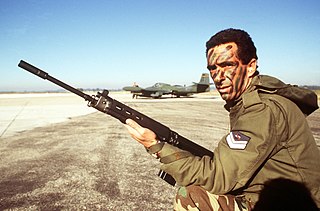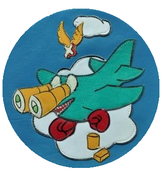
The 67th Cyberspace Operations Group is a unit of the 67th Cyberspace Wing. Headquartered on Kelly Field Annex's Security Hill, the group is an Air Force information operations unit.

15th Attack Squadron is a United States Air Force unit assigned to the 432d Wing, 732nd Operations Group at Creech Air Force Base near Indian Springs, Nevada. It flies the General Atomics MQ-9 Reaper remotely piloted aircraft.

The 75th Air Base Wing is a wing of the United States Air Force based out of Hill Air Force Base, Ogden Utah. It provides base operating support for the Ogden Air Logistics Complex, the 388th, 419th Fighter Wing, 84th Combat Sustainment Wing, 309th Maintenance Wing, 526th ICBM Systems Wing, 508th Aircraft Sustainment Wing and 25 associate units.

The 77th Aeronautical Systems Wing is an inactive United States Air Force unit, last assigned to the Aeronautical Systems Center at Wright-Patterson Air Force Base, Ohio.

The United States Air Force's 7th Space Operations Squadron is an Air Force reserve space operations unit located at Schriever Air Force Base, Colorado.

The 69th Reconnaissance Group is an inactive United States Air Force that was part of Air Combat Command, the group was stationed at Grand Forks Air Force Base, North Dakota where it was a tenant of the 319th Air Base Wing.

The 436th Training Squadron is a non-flying training squadron of the United States Air Force. The 436th Training Squadron, located at Dyess Air Force Base, Texas, is a geographically separated unit within Air Combat Command’s 552nd Air Control Wing, at Tinker Air Force Base, Oklahoma.

The III Reconnaissance Command is a disbanded United States Army Air Forces unit. Its last assignment was with Third Air Force stationed at Rapid City Army Air Base, South Dakota, where it was inactivated on 8 April 1946. After transferring to the United States Air Force in September 1947, it was disbanded in October 1948.
The 74th Reconnaissance Group is an inactive United States Air Force unit. It was last assigned to the 91st Air Division at Stewart AFB, New York.
The II Air Support Command is an inactive United States Air Force unit. It was last assigned to Third Air Force at Biggs Field, Texas, as the II Tactical Air Division, where it was inactivated on 22 December 1945.

The I Tactical Air Division is an inactive United States Air Force unit. It was last assigned to Second Air Force, based at Biggs Field, Texas. It was inactivated on 22 December 1945.

The 53rd Electronic Warfare Group was a component of the 53rd Wing of the Air Force Warfare Center, Air Combat Command, headquartered at Eglin Air Force Base, Florida.

The 14th Weapons Squadron is a United States Air Force unit. It is assigned to the USAF Weapons School, stationed at Hurlburt Field, Florida.

The United States Air Force's 1st Air Support Operations Group is a combat support unit located at Joint Base Lewis-McChord, Washington. The group provides tactical command and control of airpower assets to the Joint Forces Air Component Commander and Joint Forces Land Component Commander for combat operations.

The 3rd Special Operations Squadron flies MQ-9 Reaper Remotely Piloted Aircraft and is currently located at Cannon Air Force Base, New Mexico. The squadron is under the command of the Air Force Special Operations Command.

The United States Air Force's 25th Air Support Operations Squadron is an Air Force Special Warfare unit located at Wheeler Army Airfield, Hawaii. The squadron provides tactical command and control of air and space assets to the Joint Forces Air Component Commander and Joint Forces Land Component Commander for combat operations.

The 375th Bombardment Squadron is an inactive United States Air Force unit. Its last assignment was with 308th Bombardment Wing at Plattsburgh Air Force Base, New York.

The 541st Bombardment Squadron is the former name of the 541st Special Operations Squadron, an inactive United States Air Force (USAF) unit. During World War II the 541st served as a heavy bomber training unit until inactivated in a general reorganization of Army Air Forces training units. The squadron was redesignated in 1985, when it was consolidated with two other units.

The 2nd Troop Carrier Squadron is an inactive United States Air Force unit. It was last active in the reserve with the 65th Troop Carrier Group at Mitchel Air Force Base, New York where it was training with Curtiss C-46 Commandos. It was replaced by another unit, which absorbed its resources on 1 April 1953.

The 24th Tactical Air Support Squadron was a ground attack squadron of the United States Air Force. It was last active at Nellis Air Force Base in Nevada, prior to being inactivated during December 2020.





















